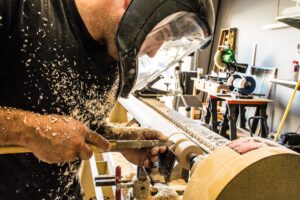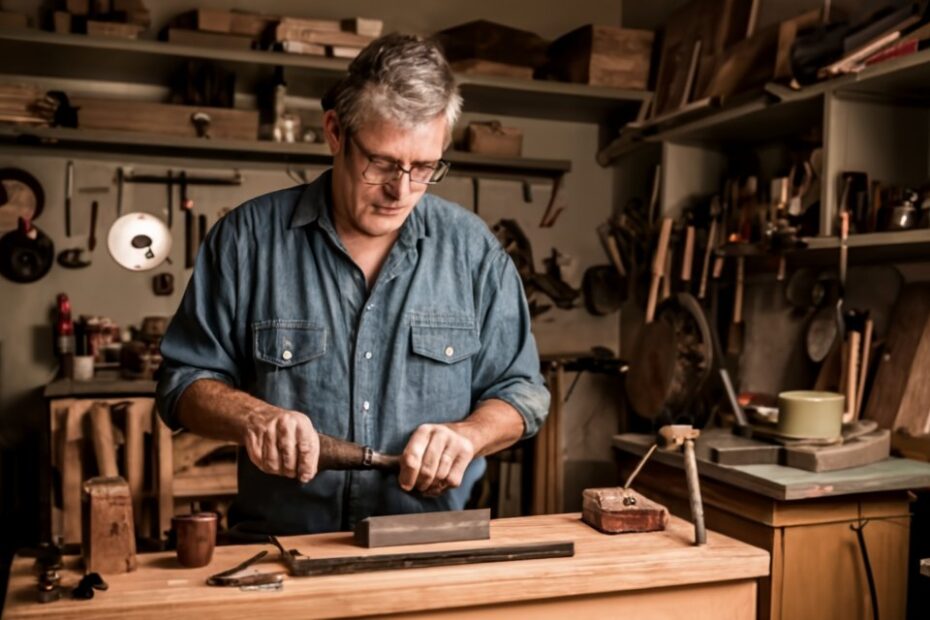Have you ever wondered if there’s a secret to achieving a razor-sharp edge on your woodturning tools? Well, the truth is, sharpening your woodturning tools is not as complicated as it may seem. In fact, with the right knowledge and tools, you can easily bring your dull tools back to life and enhance your woodworking experience.
So, if you’re ready to discover the key to achieving exceptional sharpness and precision, keep reading to uncover the step-by-step process and honing techniques that will revolutionize your woodturning game.
Understanding Different Sharpening Systems
To gain a comprehensive understanding of different sharpening systems, familiarize yourself with the various options available in the market. When it comes to sharpening woodturning tools, choosing the right grit is crucial. The grit refers to the size of the abrasive particles on the sharpening medium, such as a grinding wheel or a sharpening stone.
For woodturning tools, it’s recommended to start with a coarse grit, around 80-100, to remove any nicks or damage on the tool’s edge. Once the initial shaping is done, you can progress to a medium grit, around 180-220, to refine the edge further. Finally, a fine grit, around 320-400, can be used for the final honing of the edge.
In addition to choosing the right grit, it’s important to avoid common mistakes when sharpening woodturning tools. One common mistake is applying too much pressure while sharpening, which can lead to overheating and damage the tool’s temper. Another mistake to avoid is neglecting the proper angle of sharpening. Each woodturning tool has a specific angle that should be maintained for optimal performance.
Lastly, ensure that the entire bevel is evenly sharpened, as neglecting certain areas can result in an unbalanced tool.
Gathering the Necessary Sharpening Tools

Are you wondering what tools you need to gather for sharpening woodturning tools? To achieve the best sharpening results and maintain the longevity of your woodturning tools, it’s essential to have the right tools at your disposal.
Here are five must-have items for sharpening your woodturning tools:
- Grinding Wheel: Invest in a high-quality grinding wheel specifically designed for sharpening woodturning tools. Look for a wheel with a grit size suitable for your needs, as different tools require different levels of sharpening.
- Honing Guide: A honing guide ensures consistent and accurate sharpening angles. It helps maintain the correct bevel angle, resulting in a sharper and more efficient cutting edge.
- Diamond Plates: Diamond plates are excellent for removing nicks or reshaping damaged edges on your woodturning tools. They provide a flat and abrasive surface for precise sharpening.
- Sharpening Jig: A sharpening jig holds your woodturning tools securely in place while you sharpen them. It allows you to achieve consistent results and helps prevent accidental slips or mistakes.
- Strop: A strop is used for the final polishing of your woodturning tools. It helps remove any remaining burrs and gives your tools a razor-sharp edge.
Preparing Your Woodturning Tools for Sharpening
Before you can begin sharpening your woodturning tools, it’s crucial to properly prepare them. Preparing your tools ensures that they’re in optimal condition and ready for the sharpening process.
The first step in preparing your tools is to clean them thoroughly. Remove any debris, such as wood shavings or dust, that may have accumulated on the tool. This can be done using a stiff brush or a cloth.
Next, inspect the tool for any damage or wear. Look for any chips, cracks, or dull edges that may need to be addressed before sharpening. If you find any issues, it’s important to fix them before proceeding.
Additionally, it’s essential to check the tool’s handle and ensure that it’s securely attached. A loose handle can affect the stability and performance of the tool.
Finally, make sure the tool is properly oiled and lubricated. This will help prevent rust and ensure smooth operation during sharpening.
Step-By-Step Sharpening Process for Woodturning Tools
You can effectively sharpen woodturning tools by following a step-by-step process that ensures precision and optimal performance. Here is a guide to help you in sharpening your woodturning tools:
- Choosing the right sharpening stone: Select a stone that suits the type of tool and the level of sharpening required. Oil stones, water stones, and diamond stones are commonly used for woodturning tool sharpening.
- Inspect the tool: Before sharpening, carefully examine the tool for any damage or dull edges that need attention. It’s important to address any issues before proceeding with the sharpening process.
- Establish the bevel angle: Determine the appropriate bevel angle for your specific tool. This can be done using a honing guide or by referencing the manufacturer’s recommendations.
- Sharpening the tool: Begin by lubricating the sharpening stone with water or honing oil. Hold the tool securely and make smooth, controlled passes across the stone, maintaining the established bevel angle. Repeat this process until a sharp edge is achieved.
- Common mistakes to avoid: Avoid applying excessive pressure while sharpening, as this can result in overheating the tool or causing uneven sharpening. Additionally, be cautious of accidentally changing the bevel angle during the sharpening process.
Honing Techniques for a Razor-Sharp Edge
To achieve a razor-sharp edge on your woodturning tools, mastering honing techniques is essential. Proper tool maintenance plays a crucial role in maintaining the sharpness of your tools and ensuring optimal performance. Honing is the final step in the sharpening process and involves refining the edge to achieve the desired level of sharpness.
One common mistake to avoid when honing woodturning tools is applying too much pressure. It’s important to remember that honing is a delicate process that requires a light touch. Applying excessive pressure can cause the tool to lose its temper, resulting in a dull edge. Instead, use gentle, controlled strokes to hone the tool and maintain its sharpness.
Another mistake to avoid is neglecting to use the correct honing angle. Each tool has a specific angle at which it should be honed to achieve optimal cutting performance. Using the wrong angle can lead to a dull edge or an edge that’s prone to chipping. It’s important to consult the manufacturer’s guidelines or seek advice from experienced woodturners to determine the correct honing angle for your specific tool.
Conclusion
In conclusion, mastering the art of sharpening woodturning tools is essential for achieving precise and smooth results in your woodturning projects.
Did you know that a sharp tool can reduce the risk of accidents and injuries by up to 50%?
By using the right sharpening system and following the proper techniques, you can maintain a razor-sharp edge on your tools, ensuring a safe and satisfying woodturning experience.
So, invest the time and effort into sharpening your tools, and unleash the full potential of your woodturning skills.
Frequently Asked Question
What grit sizes are recommended for sharpening woodturning tools?
For woodturning tools, it’s recommended to start with a coarse grit around 80-100 to remove damage, progress to a medium grit of 180-220 to refine the edge, and finish with a fine grit of 320-400 for final honing.
What are some essential sharpening tools needed for woodturning tools?
Essential sharpening tools include a grinding wheel, honing guide, diamond plates, sharpening jig, and strop. These allow for consistent angles, removing nicks/damage, and final polishing.
Why is proper preparation important before sharpening woodturning tools?
Proper preparation involves cleaning debris, inspecting for damage, ensuring the tightness of handles, and lubricating the tools. This puts the tools in optimal condition for the sharpening process.
What bevel angle should be used when sharpening woodturning tools?
The appropriate bevel angle depends on the specific woodturning tool. This angle can be determined using a honing guide or by consulting the manufacturer’s recommendations. Using the right angle is crucial.
What common mistakes should be avoided when sharpening woodturning tools?
Common mistakes to avoid are applying excessive pressure, overheating the tools, allowing the bevel angle to accidentally change, and uneven sharpening across the bevel. These can damage tools.
Why is light pressure recommended when honing woodturning tools?
Light, gentle pressure is recommended when honing to avoid losing the tool’s temper from overheating, which causes it to lose sharpness. The correct honing angle for the specific tool should also be maintained.

I’m James Brown, the founder and editor of DIYINUSE.COM. I have over 15 years of hands-on woodworking and DIY experience that I share through tips and project inspiration on my website. When I’m not working on home improvement projects or creating content for the site, I enjoy spending time outdoors hiking and fishing. I’m always looking to expand my creativity and DIY skills by learning new techniques.
